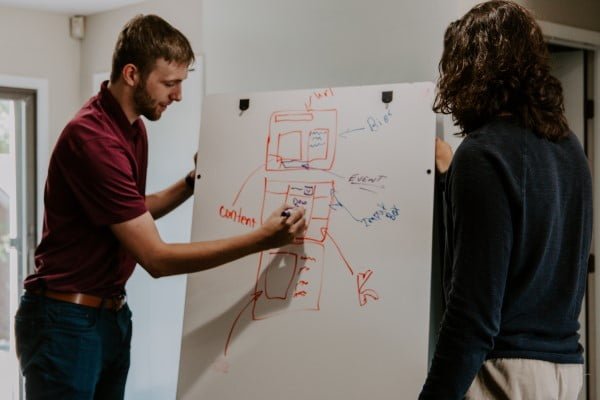Visual project management is a relatively new idea that combines data visualisation methodologies and visual thinking tools with the more traditional concepts of project reporting, communication and the practices linked to facilitation.
Visual project management is a somewhat revolutionary approach that combines the latest data and information presentation techniques in a way that improves both understanding of that information which is essential to a project such as key performance metrics.
Project management is always data-driven, whether you are manipulating, capturing, transforming of communicating with any number of people on a range of data points relating to a project you are immersed in that data. The world of business is changing at an increasing pace. In order to ensure that you keep ahead when it comes to all of the data necessary to keep everything under control, it is vital to search out new and innovative techniques and tools. This way, effective decisions can be reached on where it is most appropriate to direct resources and money.
It might be argued that the world of a project manager is already full of visualisation when it comes to data, and this is true in many respects. While the more traditional visualisations such as Kanban boards and project team calendars all have their own important place in the world of project management, they do not give the full story of the performance or status of the project.
Just as the business world is changing rapidly, so too are the time constraints on stakeholders and busy executives who no longer have the time for frequent or lengthy project updates. Decision making needs to be done in an instant using the facts that are at hand. This means that those project management concepts that relied on more complex processes are being left behind, and agile-based methods continue to become popular.

Visual Project Management
With less free time and frequent calls on what time they do have, many project stakeholders and executives simply do not have the time that they were once able to devote to lengthy weekly reports. Nor can they afford the time to attend meetings that will simply give them information that they can all too easily obtain in other forms. Those who make the decision in projects need to be constantly aware of when they need to be actively involved and when they can just oversee things. It is no longer an acceptable option to approach decision making in the same way as previously.
Agile methodologies are increasingly pushing traditional structured approaches to the side. The way in which work needs to be managed and conducted is changing to something that is much more innovative, but this was not necessarily the intention. The Agile movement was never put in place to get rid of more traditional methods but rather to make it an altogether simpler overall process that was more fluid and created less paperwork.
Many companies may still be using more traditional project management methodologies, but the way in which people work has changed. Visual project management, which employs a new more customised approach, is becoming increasingly popular in the world of project management. The concept is simple: project related information is presented in an often graphical, visual manner which can offer a clearer understanding of project details. Visual project management is another tool that project managers can use to assist in their project and can help by providing:
- Project statuses at a glance
- Project tracking status in real-time
- Issue management and resolution status in real-time
- Data-rich environments that help to promote improved decision making

The information that is provided using visual project management is more easily digestible. Anyone can look at it, no matter what time, place or even manner works for them – it can simply be slotted into a busy schedule when there is a window. The more traditional push method of communication only makes this information available when and how it is most convenient to the project manager. There is no option given to the person receiving the information on when they receive it or even the format that they might receive it in – it might be by email or conference call.
More and more information is now being made readily available in electronic form so that it can be digested when the recipient is not busy and can give it their full attention. With this method, the information is posted in a common location, people then choose to visit that location and find it when they want to access it and more importantly, view only the information they wish to receive.
Perhaps most importantly, it offers everyone involved in the project the opportunity to discuss what data relating to the project is vital to them. This allows the project manager to put together information that most effectively tells the stakeholder everything they need to know.
The concept of data visualisation
With everything moving so fast in today’s busy global environment, “big data” is becoming increasingly common. This is data that is generated continuously and is continuously being added to. On its own, the raw data means very little. However, when it is collected and then viewed in the appropriate setting, it becomes an incredibly valuable resource.
As business challenges increase and become more complicated, project managers and stakeholders are finding that it is increasingly difficult to create a logical order from the sheer amount of data that they need to study. There are so many details on paper that need to be sifted through in order to see precisely what is going on. When someone starts writing this information in a logical order on a whiteboard it suddenly becomes so much clearer.

This is data visualisation and is a valued technique that can be used to communicate complex amounts of data by altering them and presenting them is a more graphical way in order to aid with visual comprehension and processing. In this way data is easier to understand, and simpler to use for communication and analysis.
Edward Tufte, one of the early pioneers of the theory of data visualisation, said that graphical displays should:
- Display the data
- Allow the viewer to consider the substance rather than the graphic design, methodology, the technology of graphic production or anything else
- Avoid distorting the message that the data contains
- Present a lot of numbers in a small space
- Make large data sets simpler
- Encourage the eye to look at different sets of data and compare them
- Consider the data on several levels, from a broad overview to the finer structure.
- Serve a purpose that is reasonably clear: exploration, description, tabulation or decoration.
- Be closely integrated with the verbal and statistical descriptions relating to a data set.
- Graphics show data. They can be much clearer.
Recently, data visualisation has become a more active area when it comes to teaching, developing and research, with many professionals moving into speciality areas with their own applications such as:
Informational graphics: these are information, data or knowledge presented in graphical visual forms, they offer complicated information in an easy to understand and quick style. Graphs can be used to help see trends and patterns.
Visual literacy: interpreting, negotiating and creating meaning from information given as an image and further extending that meaning to written text. This is based on the idea that you can read pictures, and this can help communicate meaning.
Exploratory data analysis: this approach looks at statistical modelling as a way of analysing data sets in order to look at their main characteristics, most commonly using visual methods.

Tools used in visualisation
There are a number of common tools that are used in visualisation, including:
- Charts
- Graphs
- Diagrams
- Drawings
- Pictograms
- Ideogram
- Schematics
- Data Plots
- Maps or Cartograms
- Tables
- Technical Drawings or Illustrations
These tools can be used to generate results that can then be further used to conduct some analytical tasks, for example, showing cause and effect of trends and cycles. They can also indicate anomalies and even repeating processes.
One reason that visual project management i.e. this data conversion into graphical representation, is such an important factor is that they way in which the human mind understands complex processes better can be linked to the fact that we are naturally more predisposed to understand information provided in pictorial form; Visual Thinking.
The concept of visual thinking
At the very heart, visual thinking is an entirely natural process that indicates how the human mind processes and captures the world in its visual form. Visual thinking or the process of seeing words as images or pictures is a phenomenon that is common in around 60-65% of the world’s population. That means that around two-thirds of the people anyone interacts with can process information in this way in their mind.
It would appear that the brain does not take any longer to process words compared to pictures and that, in fact, reading in its own right might be considered a form of visual thinking. Humans, in general, see letters as their own individual pictures, and therefore words become patterns.
Scientific studies that have been conducted on the matter have shown that vision has more neurons dedicated to it than any other one of the senses, not just on their own but combined. They have further shown that at least 50% of the tissue in the brain is devoted to vision, whether directly or indirectly. And when the eyes are open two-thirds of the brain’s electrical activity is used for vision purposes.
This scientific research indicates that the human brain is already highly geared up for the idea of visual thought processes and that most of the population already identifies with thinking and learning in terms of visual objects. So how is it possible to use this natural ability and further enhance it so that is can be utilised within an organisation to encourage improved productivity? The answer to this lies in the formation of the principles of core visual thinking that pertain to organisational and learning development.
Visual thinking is just one key area of academic focus and is a combination of the studies of storytelling, visual perception, neuroscience, art, colour theory and graphic design, to name just a few. It is more than the black and white that is mostly used for word processing and spreadsheets. A wide variety of tools are used in order to bring together the ideas and concepts that offer up complex concepts and really bring the idea that a picture is worth a thousand words to the front.
While many people think that visual thinking is only an individual activity, this is a common misconception. It is true that actual thought-processing is an individual activity. However, it can become a group activity when these ideas and concepts are put into a visual form. Visual thinking activities can be a valuable tool for any organisation, offering them a significant increase not only in understanding but also further ideas born from the different ways in which people can interpret what is in front of them.
Final Thoughts in Visual Project Management
There is so much more for the project manager of today’s busy workplace to manage. It isn’t just about communication, time and project scope. As well as managing all of this, they are also required to deal with large amounts of data relating to the project. They need to be able to not only manage these vast amounts of data but also create visuals that can be used by stakeholders to fully understand the data in a clear and precise way. With so many new expectations project manager are required to have the new visual project management skills
that will make this possible. It is no longer enough to be able to provide a variety of different information in different ways; it must be presented in a quick and easy to digest manner that everyone will understand.